AG Tire Talk Key Takeaways
ALLIANCE: Recommended wheel widths are very important, when it comes to getting all that you have paid for in a tire. Sure, you may use a narrower or secondary recommendation. Unfortunately, you could lose a variety of benefits and may not even know it.
MICHELIN: I highly recommend using the recommended wheels, as this will ultimately result in increased traction, better flotation, reduced soil compaction, improved fuel efficiency and even longer tread life.
CONTINENTAL: Changing or modifying the rim width, along with the flange height, would affect the tire performance, since the deflection area in the sidewall will change. A change in the deflection area on the sidewall will have an impact on the ground contact area, affecting mainly traction and flotation.
PRECISION INFLATION: When Tire is mounted on Alternate 15” Rim, TIRE SECTION WIDTH (1” x 40% ) = 0.4” NARROWER vs Design 16” Rim.
TITAN: Many flotation sprayer conversions using the 650/65R38 conventional tires have been allowed to be installed on 18” wheels. An issue may occur if that customer decides to convert from standard 650’s to IF/VF650/65R38’s installing them on 18” wheels. Running the tire at lower inflations and higher deflections on a narrow wheel in this particular case will cause premature failure and should be avoided.
MAXAM: For any farmer or grower, selecting the right wheel and tire combination will maximize his equipment’s performance by optimizing his load carrying capability while delivering the necessary power to plow, plant, harvest, or spray his crops.
CEAT: The Recommended Rim will have the best bead to bead distance for seating the bead properly, maximizing the sidewall deflection and providing the best weight distribution within the footprint. This also allows the tire to provide maximum traction and flotation.
TRELLEBORG: A conventional 480/80R50 tire has a recommended rim size of 15” (15 x 50”) but when referring to the VF 480/80R50 tire, the recommended rim size is 16” wide rim (16 x 50”). There is one exception to this rule and that is when the IF or VF tire is marked as NRO (Narrow Rim Option) version, then the VF tire can use the same rim size as the conventional tire.
BKT: The bead package in the IF/VF version is heavier and the DW wheel makes mounting easier with less chance of damaging the bead of the tire. The wider wheel allows the IF/VF technology to work to its potential.
Alliance Tire Americas
Nick Phillippi: National Product Manager
“Rims” normally refers to the outside rolled metal, and a “wheel” is a rim with the center installed, either welded or mechanically.
Most rim widths are set by TRA standards and follow a rule for the overall width of the tire. BUT because IF and VF tires “squat” further and that outward pressure under loads puts more stress and “pull” on the bead areas, IF and VF rim fitments are normally always one size larger—1 to 2 inches—than a standard tire or the same width.
Follow the manufacturers guidelines shown in the load/inflation charts, as in the illustration. Using the optimum-sized rim means your tires will deliver their optimum footprint and last longer.

As important is not only the rim width but in some cases the rim type, which would be speaking to the rim flange design and the drop center design. In a few cases, it may also differentiate between a multi-piece rim vs. a single-piece rim construction.
When changing sizes, you also have to be aware of the disc offset of the rim, a measure of the relationship between the centerline of the wheel and its disc, or mounting surface. Offset is important to make sure your tire has enough clearance from suspension parts, fenders or even the body of your equipment. If you’re going with a wider tire, you may very well need a rim that has the rim further “out” for clearance and will need the offset of the disc to be more positive than the original wheel.
Finally, make sure that the rim and wheel assembly is capable of carrying the load you will be putting on it.
The bottom line is that working with your tire dealer to select the proper rim for your tire is important for safety as well as to ensure the proper performance and best longevity from your tire.
Recommended wheel widths are very important, when it comes to getting all that you have paid for in a tire. Sure, you may use a narrower or secondary recommendation. Unfortunately, you could lose a variety of benefits and may not even know it.
Michelin Ag
David Graden: Operational Market Manager – Agriculture
Back when Michelin invented the first Ultraflex (IF/VF) tires, they were based upon research that showed changing the flex point in the sidewall of the tire actually elongated and widened the footprint. As a direct result, we have seen with IF/VF increased traction, better flotation, reduced soil compaction, improved fuel efficiency and even longer tread life.

On IF/VF tires, we didn’t simply change the load/inflation tables. In fact, we changed the core design of the casing. By reducing the amount of rubber in some places and adding rubber to others, we caused the sidewall to naturally flex at a different point than standard tires, while maintaining a very flat footprint. As a result, we typically recommend a slightly wider wheel for these tires to optimize performance, as this wider footprint could add varying degrees of additional strain to the bead area of the tire. Also, the wider recommended wheel provides the maximum footprint, as this is the wheel the tire was designed and tested on, as shown below:
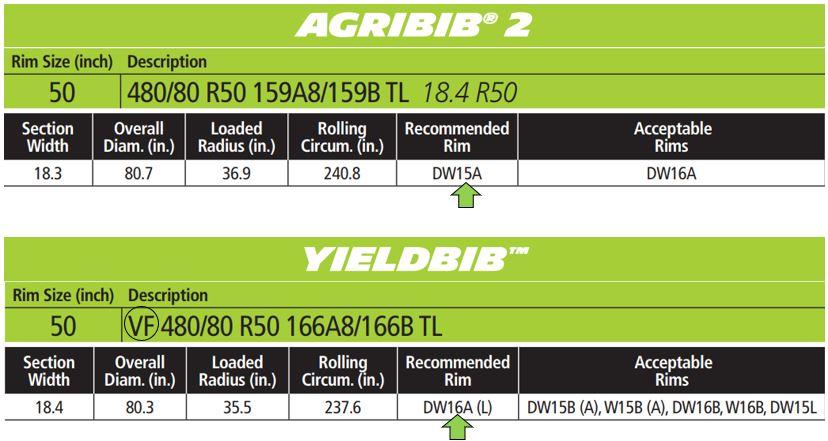
To be clear, recommended rim always optimizes traction and flotation; however, all acceptable rims listed by the manufacturer will provide adequate performance and will meet requirements of all warranties.
It’s also important to note wheel width has a bigger impact on lower profile tires. Tires with a higher sidewall aspect ratio will see less bead area stress than those with low sidewalls. Take, for example, our VF 480/95R50 Yieldbib vs VF 480/80R50 Yieldbib. The sidewall height on the 480/80R50 is about 3 inches shorter. Due to the larger deflection zone, the taller sidewall 480/95R50 will be much more forgiving with a narrower wheel than the lower sidewall 480/80R50.
To summarize, the tires of today are designed to perform at their maximum potential on the recommended wheels. If you have to choose a narrower wheel, you may change the performance and longevity of your tire investment. I highly recommend using the recommended wheels, as this will ultimately result in increased traction, better flotation, reduced soil compaction, improved fuel efficiency and even longer tread life. It will give you a lower total cost of ownership and add more to your bottom line.
Precision Inflation, LLC
Ken Brodbeck, VP of Technology
Does Rim Width Matter?
The short answer is yes.
Design Rim Width is listed in both the Tire and Rim Year Book and by individual tire manufacturers. They may or may not agree with each other. Your best choice is to check each manufacturer’s data book or website for their design and alternate rim widths.
Definitions
Design Rim: is the Rim Width that the tire is designed to and molded at the factory for Optimum Performance.
*It is important to note that often a tire manufacturer will call out a wider rim for an IF or VF tire compared to the standard size tire.
Alternate Rim: is an alternate to the design rim. Not the engineer’s first choice, but still a rim that the manufacturer will warrant for the tire size in question and will provide satisfactory performance.
What happens if I choose the Approved Alternate Rim Width?
- Alternate Rims cause the Tire Section Width to WIDEN or NARROW by 40% for each 1” of Rim Width Change.
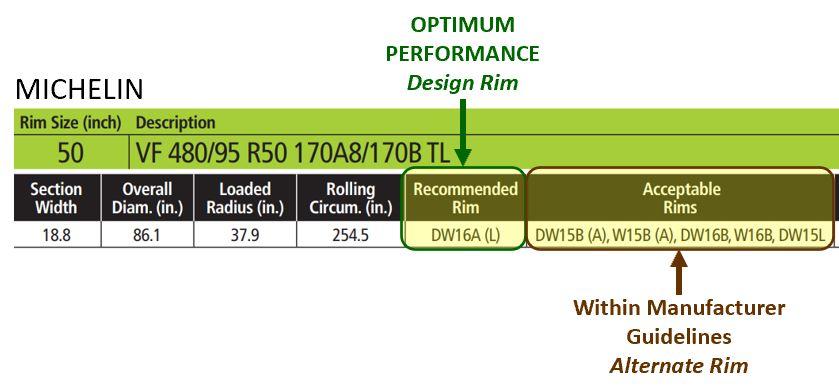 Example: VF 480/80R50
Example: VF 480/80R50
- Design Rim (Recommended) is 16” / Alternate Rim (Acceptable) is 15”.
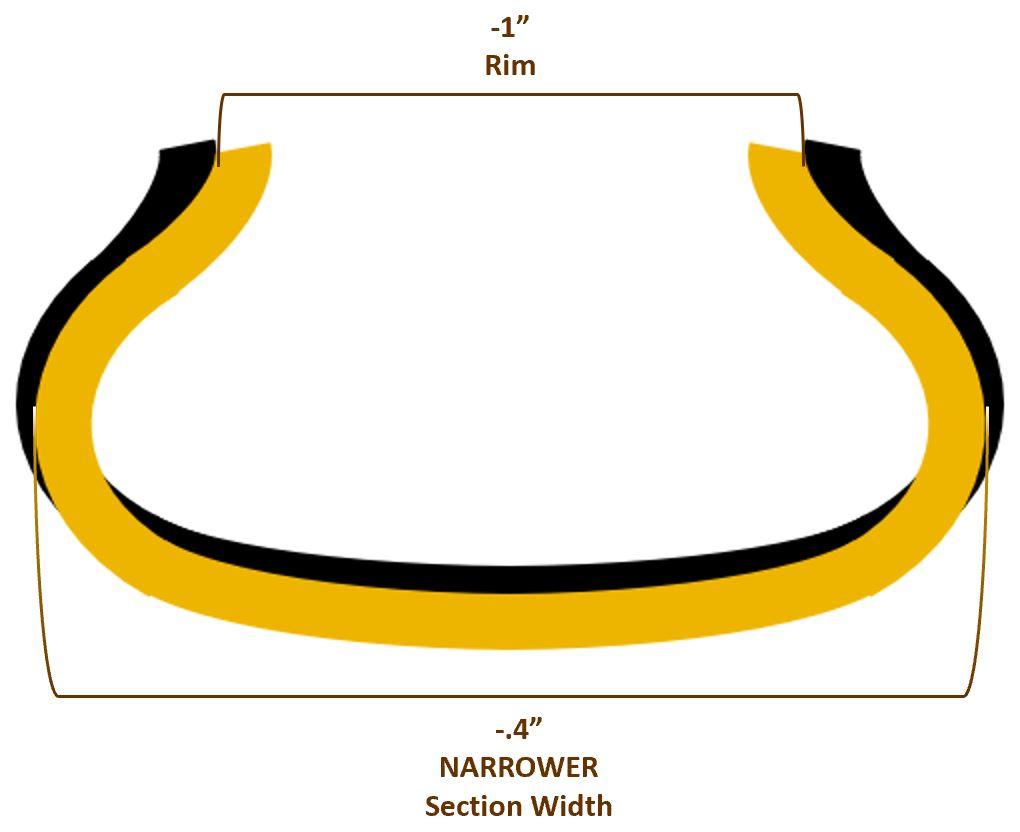
- When Tire is mounted on Alternate 15” Rim, TIRE SECTION WIDTH (1” x 40% ) = 0.4” NARROWER vs Design 16” Rim.
- Alternate rims typically have a minor impact on tread radius, traction and flotation. And I will defer to the tire manufacturer’s comments on these parameters.
- Choosing a rim that is neither design or alternate now pushes a tire into a configuration that can significantly alter the tire’s performance including creating irregular wear and durability issues that the manufacture may not cover under warranty.
- NOT RECOMMENDED
Bottom line: If you are starting out with a new tire on any machine, your best choice is to select the design rim.
Second choice is the approved manufacturer’s alternate rim found in their data book or website.
Lastly, any rim outside design or alternate will likely cause you problems and could lead to the tire coming out of service prematurely along with voiding the tire’s warranty.
Continental Agriculture North America
Harm-Hendrik Lange: Customer Solutions Engineer for Continental Commercial Specialty Tires (CST)
Agriculture tires have a flexible carcass construction to enable a wide footprint with good traction and low inflation pressure for low soil compaction. This flexibility, especially for tires with high aspect ratios, allows the tire to operate within certain variations in rim width. Therefore, the farmer can change to a slightly different tire width without requiring a new rim.
Changing or modifying the rim width, along with the flange height, would affect the tire performance, since the deflection area in the sidewall will change. A change in the deflection area on the sidewall will have an impact on the ground contact area, affecting mainly traction and flotation. Also, a different rim width could have an impact on the mounting process, increasing the stress in the bead area.
Independent from technically possible and allowed combinations, there are other factors to consider when combining rims and tires:
- For most standard tire sizes, the optimum rim width factor is between 0.8 and 0.9 of the tire section width for ideal performance and if the tire is used with lowest inflation pressure.
- For normal usage, tires work properly on rims from 0.7 to 0.95 of tire section width.
- It’s technically possible to use an even smaller or wider rim, but in borderline usage conditions, the performance may be significantly reduced.
For example, a narrower rim:
- Reduces the tire’s ability to transfer side forces while curving on road and on inclines, meaning spongier driving behavior.
- Means higher bending stress in the tire sidewall, especially directly over the bead section, which can bring about earlier aging and cracking, particularly when deflection on the sidewall is high. The performance/ability to use the lowest possible inflation pressure for maximum traction and reduced soil compression is limited.
- Leads to less air volume in the tire which physically means less load capacity at the same inflation pressure.
The mentioned negative effects of a narrower rim may lead to the alternate idea of using the widest rim that is technically possible. The option of a wider rim can also cause negative effects:
- The tire sidewall has deflection purposes designed for a certain rim width. If the rim is too wide, the ideal deflection shape may be disturbed and some areas of the sidewall may have higher stress/bend, depending upon the tire design.
- If the distance between the rim flanges is wider than the belt width, the radial carcass forces may not support the bead being pushed towards the rim flange. In this case, the proper bead seating needs to be ensured only by the lateral force component of the inflation pressure. This force is reduced at lower inflation pressure, so the risk of tire rim-slip is increased if the rim is too wide.
- It´s very difficult to get the initial inflation pressure into a tubeless mounted tire, if the rim is too wide.
Further limiting factors are technical details like differing rim flange heights. For example: 15”, 16”, and 18” wide rims have the same rim flange height of 25.4mm. The 20” wide rim already has the bigger class of rim flange at the 29mm height. Here a classic example is the 650/65 Rxx tire. The tires are designed to fit on the 20” wide rim with the higher rim flange. From the width factors, the 18” wide rim is still above 0.7 aspect ratio of 650mm and should suffice. It works practically, but a small gap may result between the upper rim flanges and rim protection lip of the tire. As a result, we do not recommend using the 18” rims for these tires in our data book or technical datasheet of the specific tire size.
These factors can also help in finding the best tire-rim combination:
- Most tire producers recommend a specific rim width for a specific tire dimension marked with bold letters. With this rim width, the tire has its optimal performance.
- In most cases, technical data is also related to the recommended rim width.
- If the operator plans to use a wider or narrower rim than recommended, the resulting tire section width can be estimated roughly by a 10mm change of the tire section width per inch rim width. For example: The tire can be used with 15”, 16” and 18” rim width according to the data book, but data is based on a 16” rim. The user wants to combine the tire with an 18” rim and asks himself if the tire still has enough free space to the vehicle chassis. He needs to add 20mm to the tire section width when using 18” instead of the 16” rim.
- Of course, a reduced section width by a smaller rim can result in a larger diameter. But as the belt of the tire is much stiffer than the carcass, depending on the specific tire construction, the effects should be rather small.
Titan International, Inc. (Manufacturer of Titan and Goodyear Farm Tires)
Scott Sloan: Ag Product Manager / Global LSW
The Tire and Rim Association organization consists of representatives from tire and wheel manufacturers from around the country and the globe. It is their job to propose, discuss, debate and then publish new standards or modify existing ones concerning wheels and tires. Standards such allowable loads, design criteria such as OD and section width tolerances along with allowable rim widths and contours are all part of the discussion. Once published, all wheel and tire manufacturers adhere to those standards. Figure 1 and figure 2 are two examples of standards for common rim contours in the agricultural world. The standards provide dimensional tolerances specifically for each contour and the varying diameters in each.
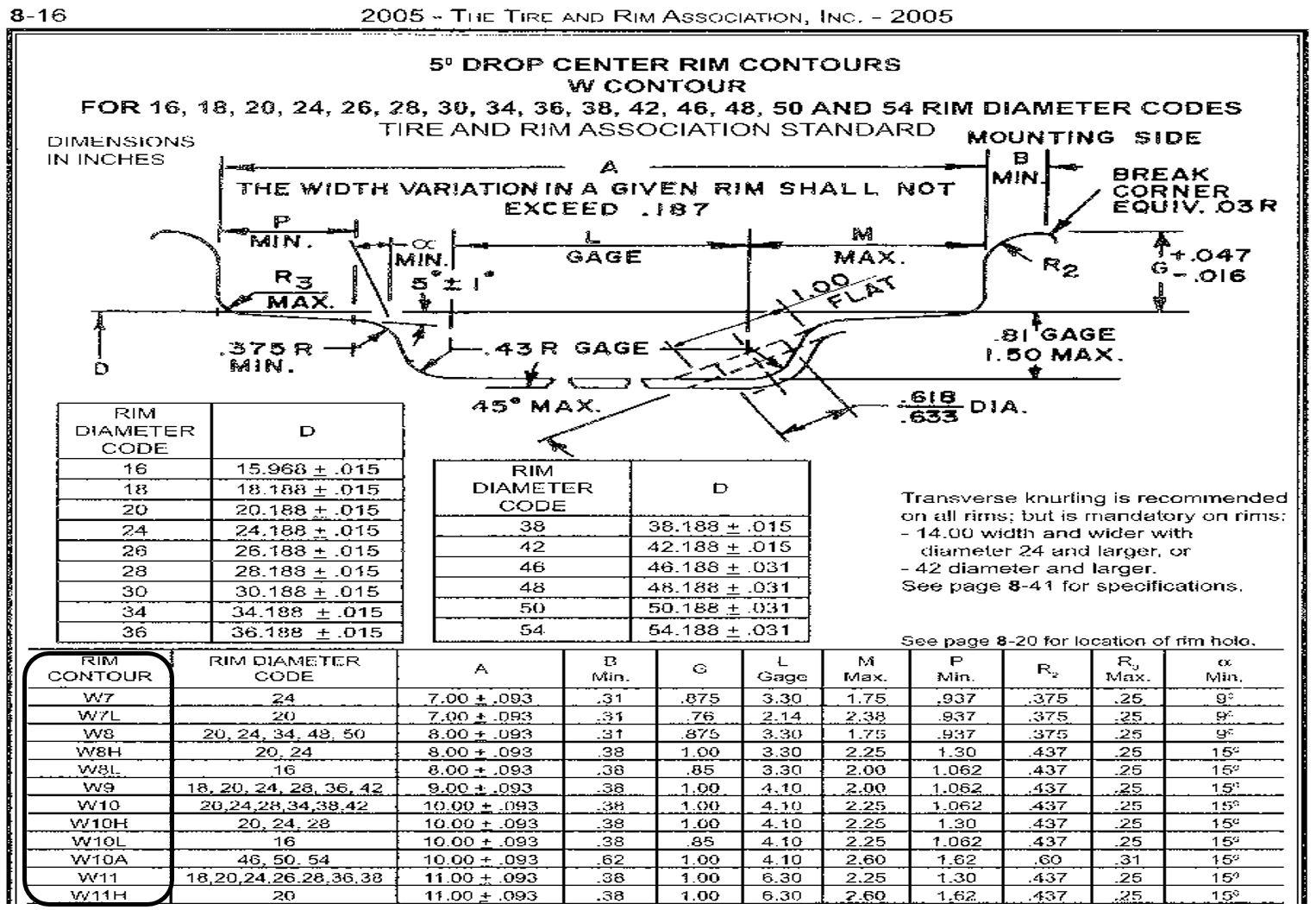
Visual 1
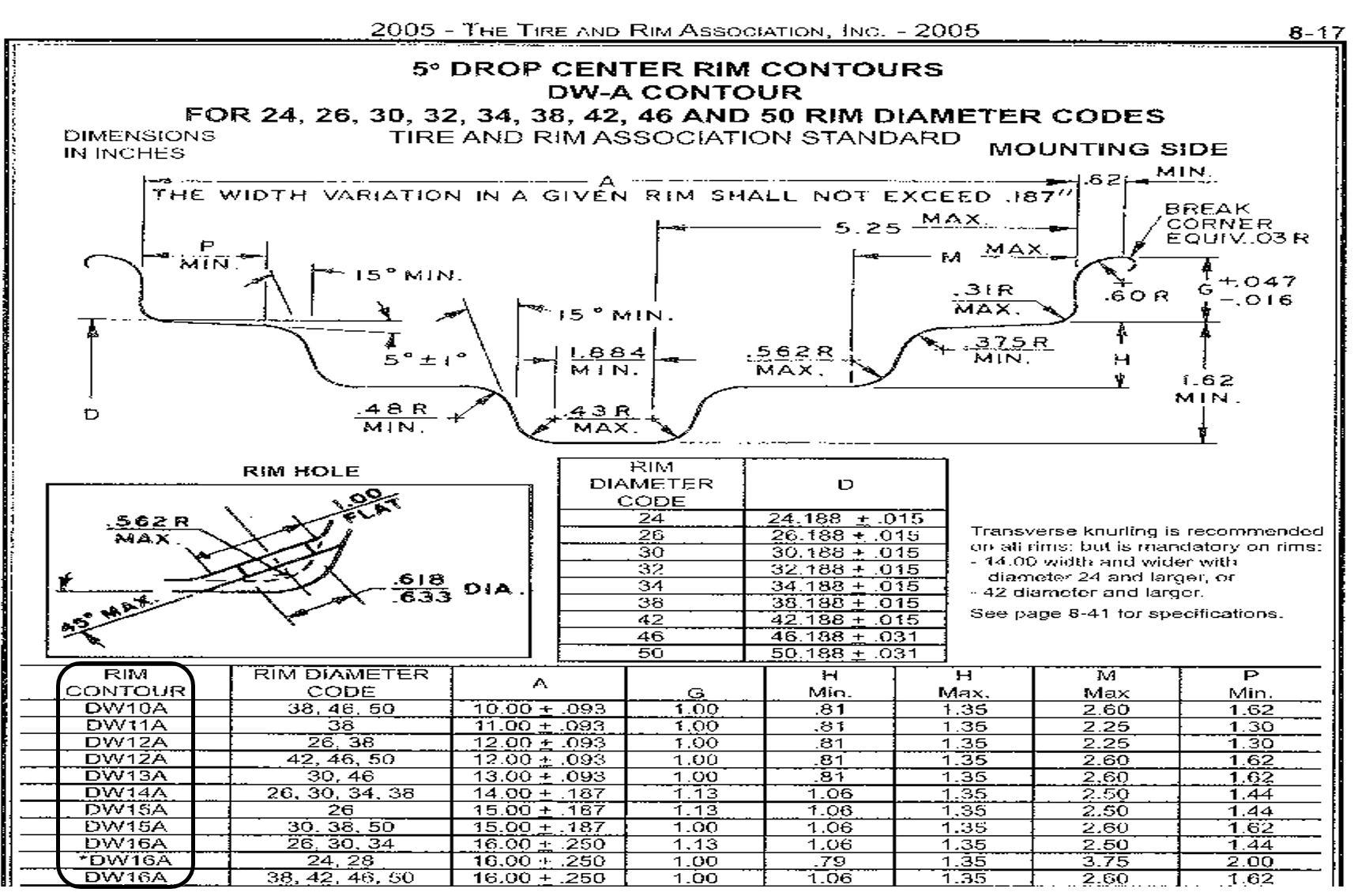
Visual 2
Tire standards are similar (see figure 3) in that they give design parameters and tolerances for each size. Along with those, it also provides the design rim width (Red column) and the approved rim contours and widths. (Green column). Based on these recommendations, equipment manufactures determine which best suits their needs from a design and cost perspective.

Visual 3
With all that being said, back to the question of what affect does the varying rim widths have on tire radius, traction and flotation, the simple answer is it has none.
With the introduction of IF/VF deflection technology, testing was done to see what affect or performance improvement could be gained with regards to tire longevity. For years, the tone was to keep the air in the tires and reduce the amount of deflection to minimize tire failures in the field. Now we were saying it was okay to let 20% and 40% of the air out of the tires without any real field experience. What was determined is that IF/VF tires running on wider rim widths actually saw an improvement in durability. Moving the beads out from the centerline actually moves the stress and deflection from the beads up into the sidewall, which is designed to flex, and results in improved longevity. For example, one of the first IF/VF tires in the market was the 380/90R46 size. That tire originated from the 14.9R46 tire that had run on a 12” wide wheel for decades. As it turned out through testing, it was determined that the new recommended wheel was to be 13” wide for the IF/VF versions. This was actually a tough pill to take for the OE’s since they had been using the 12” for so long and now we were pushing them into a wider, more expensive wheel. This testing was done on numerous sizes and results were similar. Figure 4 shows the differences in the design parameters and recommended rim widths
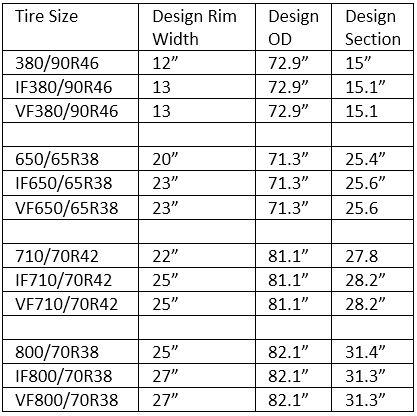
Visual 4
In some cases, tire manufacturers have independently given permission to use wheel widths that are not design or approved alternates. As an example, the 650/65R38 design rim width is 20” with an alternate wheel being 23”. Many flotation sprayer conversions using the 650/65R38 conventional tires have been allowed to be installed on 18” wheels. An issue may occur if that customer decides to convert from standard 650’s to IF/VF650/65R38’s installing them on 18” wheels. Running the tire at lower inflations and higher deflections on a narrow wheel in this particular case will cause premature failure and should be avoided. The IF/VF380/90R46 is slightly different due to the fact the design width is 13”, but the alternate is a 12”. This would not be as much of a concern.
My suggestion is if you are looking at moving to tire technologies like IF/VF, that you research your current size and wheel recommendations. Asking your local tire dealers is the best place to start. Wheels and tires work together, and to ensure you have the best chance of success starts with a little research.
Maxam Tire International
Greg W. Gilland: Business Development & Ag Segment Manager
All Agricultural tires either of radial or bias conventional construction are designed by size to fit on a certain rim seat. Depending on the equipment design or need, rims also are made in various widths to allow the tire under load to drive or steer the vehicle and provide the best load carrying capability.
In the last article of Ag Tire Talk we reviewed that radial tire construction accounts for 20% of the carcass load or pressure on the soil, while the compressed air in the tire chamber accounts for 80% of the carrying capacity. Therefore the key to a tire successfully carrying the load and delivering the expected performance is the capability of the air in the tire to suspend the load and allow the tire sidewall deflection or “Tire Bulge” under a given load to push the tire footprint to deliver the rim pull or torque to move in the desired direction.
By convention and industry agreement, tires must conform to international standards to be of a certain geometry or tire size. Depending on the desired or designed tire geometry tires are grouped in the below tire Aspect Ratio or families of sizes.
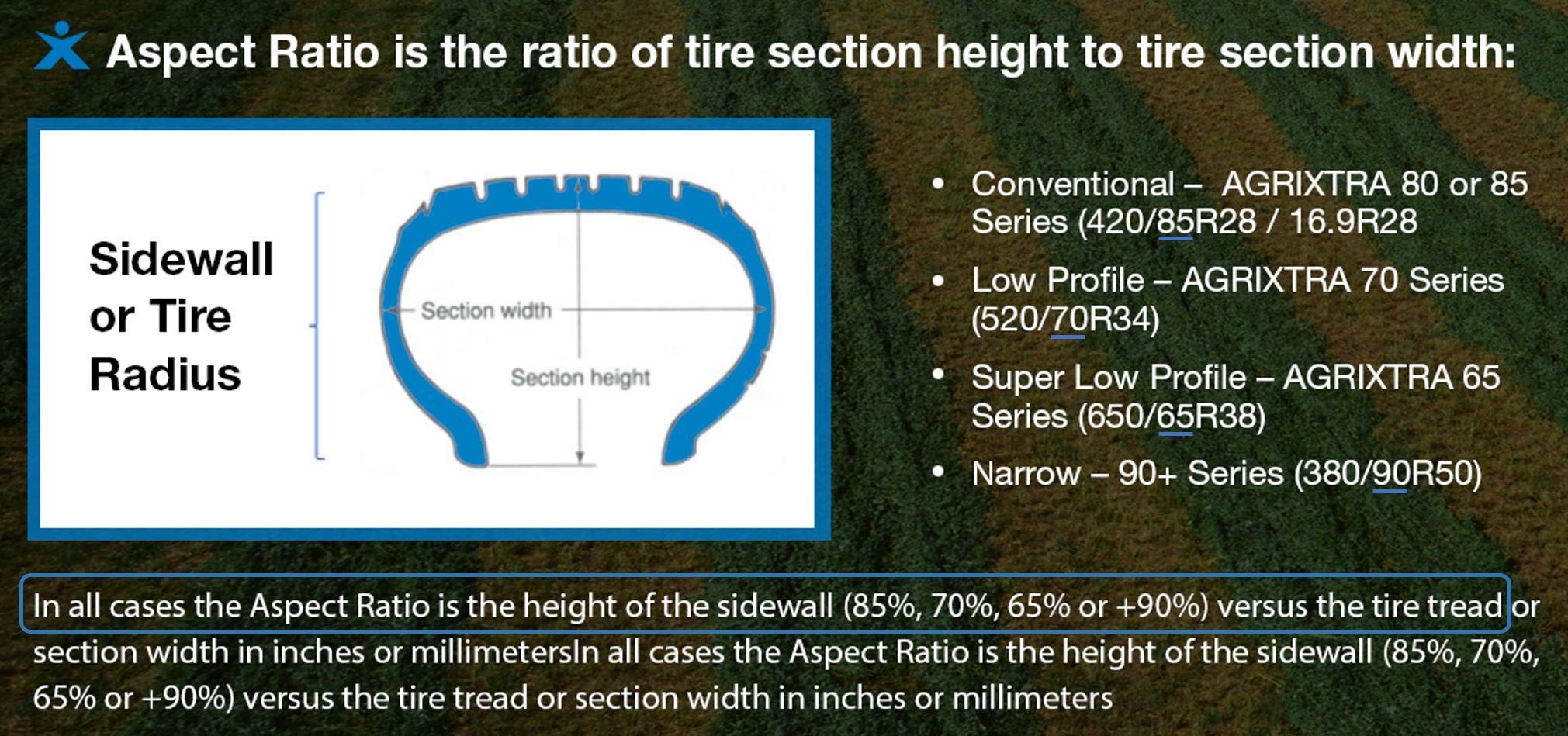
The width and diameter of a tire will determine the size of the sidewall or radius of the tire on the wheel or rim. In simple terms, the size of the tire in terms of the width or sidewall height determines the size of the air chamber or capability of the tire to carry the desired load or increased load. As the Original Equipment Manufacturers never ending quest for improved productivity via the evolution to larger machinery, tire geometry has had to evolve to meet the demand for more load, speed, and traction.
Outlined in the table below you can see a group of four tires that have the same outer diameter and proposed rim or wheel. The table details a comparison in terms of their geometry (width & diameter), aspect ratio, load carrying capability, sidewall radius and footprint:
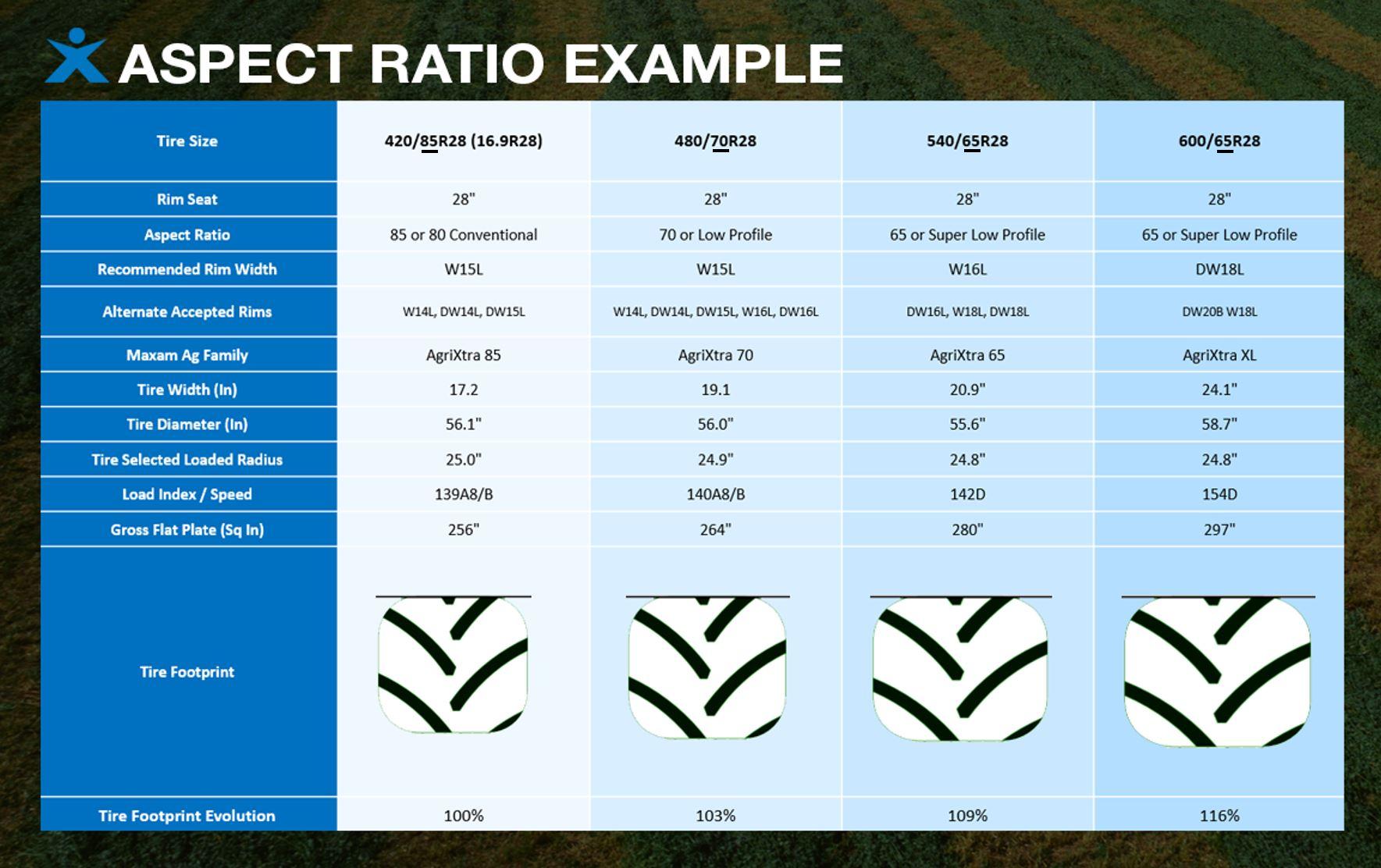
In each case, as the tires change aspect ratio or width their tire radius and diameter remain almost the same. However, the larger geometry or larger (wider) footprint (Gross Flat Plate) delivers improved flotation and increased traction.
These changes in tire geometry also result in a larger air chamber that provides increased load carrying capacity that supported by the larger tire footprint ultimately delivers improved traction, fuel efficiency, and productivity. The farmer or grower that chooses to change to a wider tire as proposed in the above comparison must ensure that the equipment has the recommended or alternative wheel widths to support the tire size selected as proposed by the tire manufacturer.
Each tire manufacturer should offer a recommended wheel width with acceptable alternative wheels or rim widths that allow their tire to deliver the optimal performance. In the above comparison, all the tires have the same loaded tire radius, yet the resulting tire construction (based on aspect ratio, width, and diameter) deliver different load carrying capabilities because of the larger air chamber and footprint allowing more weight as well as greater power transmission. In every instance, a tire is a compromise that employs the tire geometry, materials, air chamber, and compressed air working together to deliver the best possible performance. For any farmer or grower, selecting the right wheel and tire combination will maximize his equipment’s performance by optimizing his load carrying capability while delivering the necessary power to plow, plant, harvest, or spray his crops.
Trelleborg Wheel Systems
Norberto Herbener: OE Applications Engineer
When talking agricultural tires, each tire manufacturer makes recommendations for an ideal rim width in addition to two additional size options to give operating flexibility (a narrower and wider tire sizes). This recommended rim width is calculated by using standardized formulas agreed by all tire manufacturers within TRA (Tire and Rim Association) and ETRTO (Europe Tire and Rim Technical Organization). It is determined by 3 components:
- Tread width
- Aspect Ratio or Series which is the sidewall height compared to the tread width
- Technology such as bias, radial, IF (Increased Flexion), VF (Very High Flexion), or IMP (Implement)
The choice of suggesting what rim to use does not end here as there are several rim profiles to consider such as W, DW, MW, and TW. In certain sizes, this can play a role to influence the ease on mounting the tire on the rim. Note: A lower profile tire is easier to mount on a DW rim than on a MW rim.
In addition, the rim profile used by the equipment manufacturer will be influenced by their specific axle and space design. This could be an influencer if the engineer will use a DW or MW rim design. There are a few recommended principles when discussing recommended rim width, see below:
- A rim for a conventional tire is often at 80% of the tire nominal width.
- For example: A 480/80R50 tire requires a 384 mm (480 mm x 80%) rim width that represents 15.11”. The closest standardized rim width is a 15”. When choosing a 15 x 50” rim, this will assure the right tire bead pressure on the rim and avoid the tire bead from possibly unseating during use. There is not always a standardized rim width that matches exactly with the “calculated” value. This 480/80R50 tire would also fit on an additional suggested rim size of 16” (16 x 50” rim). Note: Refer to the tire manufacturer’s data book for information on the range of “permitted” rims.
- With an IF or VF technology tire, the sidewall is reinforced (to be able to carry the additional load) and stiffer on these higher technology tires compared to the conventional tire. The recommended rim size is always the next available wider size.
- For example: A conventional 480/80R50 tire has a recommended rim size of 15” (15 x 50”) but if when referring to the VF 480/80R50 tire, the recommended rim size is 16” wide rim (16 x 50”). There is one exception to this rule and that is when the IF or VF tire is marked as NRO (Narrow Rim Option) version, then the VF tire can use the same rim size as the conventional tire.
The selection of the rim width influences the total width of the tire – the wider the rim, the wider the tire (specially on the sidewall area and not on the tread width). Staying with our 480/80R50 tire, for example:
- Using a 14” rim it would decrease to 475 mm (18.7”)
- Using the recommended 15” rim the total tire width would be at 485 mm (19.1”)
- Using a 16” rim it would increase to 495 mm (19.5”)
These values are always measured at nominal air pressure. Changing between tire manufacturer permitted rim sizes will not affect the rest of the tire specifications and capabilities. The change in tire total width would have a minimal impact on tire traction and flotation. These parameters are largely influenced by inflation pressure and the load the tire is carrying.
When a customer is thinking to change a tire size that involves also a rim change in such equipment as:
- Combines, an example to switch from 620/70R42 duals to a single 1250/50R32,
- Check if the new tire fits the space occupied by the current tire (in outside diameter and width) to assure enough clearance with the equipment
- Check if the hub needs a minimum rim size due to final drive configuration, brakes and suspension (in this case we are reducing the rim size from 42” to 32”)
- Check if the load capacity of the new tire is enough for the equipment
- If these three principles are met, the final point is to find the rim with the correct bolt pattern (quantity, hole size and bolt circle) and the size of the pilot hole. Note: In most cases, the tire and rim distributor will have this information available for each equipment model.
- MFWD (Mechanical Front Wheel Drive) tractors where you have different tire sizes between the front and rear axles.
- Keep the original interaxle ratio between the original tire sizes and the new ones. Incorrect sizing could change the front axle lead percentage which can lead to a reduction in traction efficiency and potential damage to the transmission components.
In conclusion, if you’re thinking to change the tire sizing in any equipment – as a general rule of thumb is to always check on the specification and consult with your equipment dealer or your trusted tire distributor or manufacturer technician.
CEAT Specialty Tires Inc.
Jim Enyart: Technical Manager
Recommended Rim Widths are very specific due to the bead seat angle that is built into each Ag tire. The Recommended Rim will have the best bead to bead distance for seating the bead properly, maximizing the sidewall deflection and providing the best weight distribution within the footprint. This also allows the tire to provide maximum traction and flotation. The alternate wheels that might be allowed will provide for an acceptable fitment.
If you venture outside the above parameters, the bead may seat but the carcass of the tire becomes distorted. As you proceed farther from the Recommended Rim, the distortion increases and effects tire performance and longevity. Traction and possibly the flotation will be reduced when mounting tires on incorrect rim widths. When the angle of the rim and bead are not close enough to withstand high torque situations the tire can demount or slip on the rim. Demounting an Ag tire in the field is never good and rim slip will destroy the bead very quickly. In short, we always recommend staying within tire manufacturer wheel parameters.
It’s all about matching angles for the best bead to rim seating. The correct bead seating allows the tire to withstand heavy loads under high torque applications while maximizing sidewall deflection, footprint, flotation and delivering optimum traction.
If you are going to do a conversion from a VF380/90R 46 Row Crop setup to an IF650/65R 38 Flotation setup on your sprayer, there are several items to consider. The rim needs to be the Recommended Rim for the tire which is a DW23B rim. The weight rating for the rim needs to be high enough to carry the maximum load. The bolt pattern has to match the hub and the rim offset may need to be adjusted for clearance purposes.
BKT USA, Inc.
Dave Paulk: Manager Field Technical Services
All wheel rims should be selected based on the tire manufacturer’s recommended and alternate options for the specific tire being used. The Tire and Rim Association lists both Design Rim (Recommended Rim) & Approved Rim (Alternate Rim) widths and contours for agricultural tires.
A tire’s recommended rim width identifies option tire was designed to. In contrast, alternate rim width identifies acceptable options on which the tire can be mounted and provide adequate performance.

Each rim width generally works with only a few tire widths. The flange contour is also important for mounting and bead seating. Some examples of contours are W, DW, F, and L.
Using a rim wider than listed manufacturer options flattens the tread face and the stability of the tractor is affected. In hard soil, there is less lug penetration and less traction. Stress is then concentrated in the shoulder area and increases the amount of shoulder tread wear. When the tire’s beads are mounted farther apart than intended, it forces the sidewall of the tire to flex in an area lower than normal. This creates circumferential carcass breaks and sidewall separations. We do not suggest going outside listed manufacturer parameters for any reason.
Using a narrower rim than listed manufacturer options can cause mounting problems and impede the bead from seating properly to the wheel. Increased pressure from the bead to the rim flange can cause possible bead and sidewall separation to the tire and premature rim failure. The tread of the tire is rounded (like an overinflated tire), and tread wear is concentrated in the center of the tire. Therefore, traction in the field is greatly reduced. We do not suggest going outside listed manufacturer parameters for any reason.
Changing to a wider tire or IF/VF tires can increase load carrying capacity, traction, and flotation. These can be used to minimize soil compaction. When switching to these tires from standard tires, a wheel change is almost always required. If changing wheel diameters, wheels must be changed. Tires made for a 46” wheel will not fit on a 38” wheel.
An example is the 380/90R46. Although the standard version and the IF/VF versions are the same size, there are differences in tire construction that necessitates the wheel change. The recommended rim for the standard tire is a W12, but the recommended wheel for the IF/VF version is the DW13. The bead package in the IF/VF version is heavier and the DW wheel makes mounting easier with less chance of damaging the bead of the tire. The wider wheel allows the IF/VF technology to work to its potential.

Another factor to consider with wheels is air pressures and weight carrying capabilities. A wheel must be able to handle the higher air pressures and the higher loads at higher speeds without failing. In this example, going from the standard tire to the VF, there is an 18 psi increase in air pressure, 5,880 lbs. increase in load carrying capacity, and a 10 mph increase in speed.
The standard 380/90R46 155A8/B is rated to carry 8,450 lbs. at 46 psi at 30 mph.
The IF380/90R46 168D is rated to carry 12,300 lbs. at 64 psi at 40 mph.
The VF380/90R46 173D is rated ro carry 14,330 lbs. At 64 psi at 40 mph.
In the right circumstances it makes perfect sense to change sizes for more flotation, less compaction, and more weight carrying abilities. When changing wheels and tires, it is important to ensure that the tires match up to the wheels for load, speed, and inflation. This will minimize any future problems with wheels and tire failures.
All information is provided in this blog solely to provoke thought. All deductions made from information on this site must be confirmed by Certified Ag Tire Dealer before use. Ag Tire Talk does not recommend anyone conduct tire service work with exception of Certified Ag Tire Dealer Professionals.

